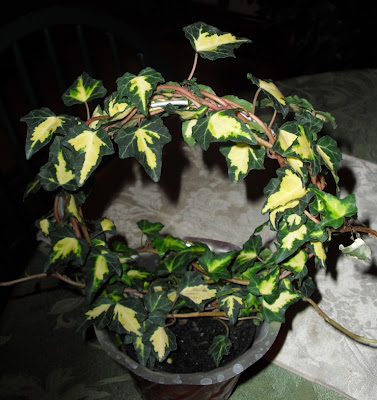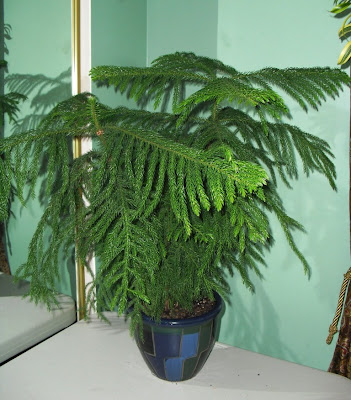The first indoor plants I can remember belonged to my grandmother. After my parents separated, my mother and I lived with my grandparents from when I was about two until I was 13. Nana had a
Begonia or two, some sort of palm, a
Syngonium she referred to as “elephant ears” and some other plants I don’t remember well enough to identify. But what she had the most of was
Epipremnum aureum, most commonly referred to as “golden pothos.” My grandmother, like many people, called these “Philodendrons” even though they aren’t. (If you want to be able to tell the difference, check out this post at
Plants are the Strangest People.) She shared cuttings with me when I first showed interest in houseplants as a child, and it has been rare that I haven’t had at least one pothos in my collection since then.
Even so, there was a brief period in my plant-growing life when I thought of pothos as being a bit too common. This was probably a result of seeing too many lackluster, somewhat neglected plants. What snapped me out of this
Epipremnum ennui was coming across a bunch of healthy, strongly variegated plants on display in a plant shop. (This was the last store I remember seeing that was totally devoted to selling houseplants. While such stores were not uncommon in the 1970s, they were almost unheard of in 1991, when this one went out of business.) Seeing pothos with fresh eyes, I came to appreciate their versatility and beauty once again.
I far prefer pothos to heart-leaf
Philodendrons (
P. hederaceum) which are also nice, but common plants. I find pothos more forgiving of various less-than-optimum conditions, including low light levels, erratic watering and getting chilled. (Pothos plants don’t like those things, but I think they bounce back better if exposed to them.) In my experience, cuttings from Pothos roots faster, and the plants produced from the cuttings seem to become more vigorous sooner. It has also been my experience that if you don’t let a Philo climb, its new leaves get smaller and smaller, even in good light. While pothos leaves tend to be larger if they are allowed to either climb or just grow horizontally on a surface, they also maintain a decent size if grown as a hanging plant.
So pothos is easy to care for, even in adverse situations. That is why they seem to be the hanging plant of choice in public spaces. Two years ago, I worked for a couple of months as a plant care technician for a large interiorscape company. For a variety of reasons, this job did not work out for me, but I did learn a few things, especially about the popularity and durability of pothos as an office plant. It was a rare account on my route that didn’t have at least one pothos, and most had several. A couple of the larger companies had hundreds of them. By contrast, there were exactly
three Philodendron hederaceum plants on my entire route. I learned that pothos responds much better to a good pruning than I had imagined. It will fill out, and produce more than one growing point, instead of just restarting the vine from the edge of the cut stem. I also learned that the yellowing of pothos leaves can be caused by over watering, but just as frequently, yellowed leaves will be the result of allowing a plant to go dry enough to wilt. Even if this wilting is followed by a good watering, more than a few of the leaves will yellow, rather than recover. I do admit that I’ve never seen a Philo respond that way, so there is a point in their favor.
Epipremnum aureum varieties I own:
Golden Pothos: This is the one most often grown, and the most durable. Grown in very low-light, the variegation becomes more muted, but does not disappear altogether. The green coloring also loses some of its richness. This is the plant most likely to be seen as boring, but the variegation on a plant grown in good light is a thing of beauty.
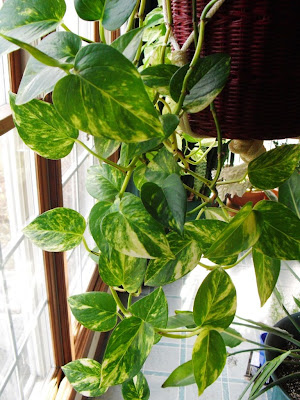 Epipremnum aureum
Epipremnum aureumNeon Pothos: I grew these from cuttings obtained during the above-mentioned foray into professional plant care. (If a plant needed pruning, the cuttings, which, at the end of the day, could number in the thousands, were just thrown away. So if a tech wanted to, he/she could keep a few to propagate. We also gave them away to any office worker who asked, as long as they were healthy and pest-free. ) This is a variety that I expected to be fussy. Not so; I find it to be a vigorous grower. Too much direct sun will cause it to have a bleached yellow appearance, while strong but indirect lighting brings out the pretty chartreuse tones. I have noticed that the cuttings can be a bit harder to root than those of the other pothos varieties, with the stems occasionally rotting before roots can form.
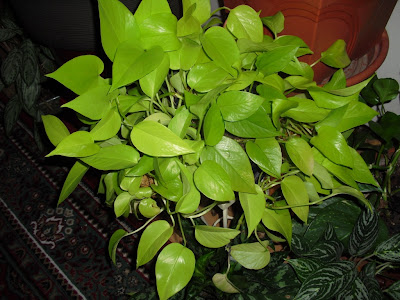 Epipremnum aureum 'Neon'
Epipremnum aureum 'Neon'Marble Queen: Probably my favorite, as I am especially fond of plants with white variegation in general. It does grow a bit more slowly than golden pothos and seems more susceptible to cold damage and to fungal diseases.
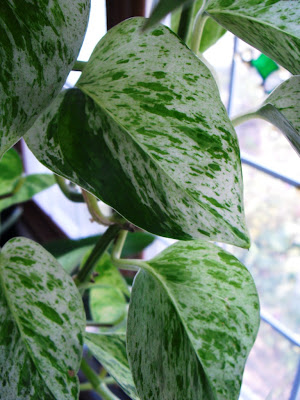 Epipremnum aureum ‘Marble Queen’
Epipremnum aureum ‘Marble Queen’
This is a close-up of the leaves of my larger plant.
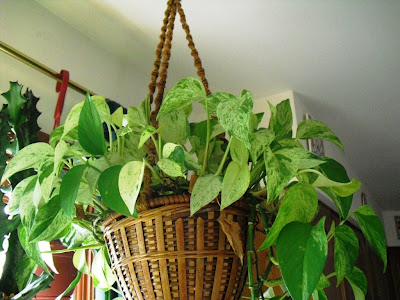 My smaller Epipremnum aureum ‘Marble Queen’You can see an all-green shoot on the left
My smaller Epipremnum aureum ‘Marble Queen’You can see an all-green shoot on the left.
Jade Pothos: In my experience, this is not the result of a golden pothos grown in insufficient light, as some believe. As mentioned above, such plants are more likely to become muted and dull than to achieve the rich, unvariegated dark-green color characteristic of this plant. Rather, jade pothos seems to be derived from
Epipremnum aureum 'Marble Queen,' which is inclined to put out all-green shoots from time to time. That is how I obtained my plant, pictured below. I cut back and propagated any all-green shoots that developed on my two Marble Queens. These shoots didn’t seem to be a result of low light, since the plants in question are in sufficient light, and put out plenty of variegated shoots. Not only that, but the Jade is in the same or better light, and it remains all green. If the green color was the result of a light issue, I’d expect to see some variegation recur when the light is increased. The all-green plant also grows much more quickly and robustly than its variegated parents, which is to be expected.
 Epipremnum aureum 'Jade Pothos'
Epipremnum aureum 'Jade Pothos'
‘N’Joy’: When I first saw this new cultivar, I thought it would be fussy and slow growing, since in my opinion, the variegation and bumpy leaf texture resembles a viral mutation not unlike that of Spathiphyllum ‘Domino,’ the variegated peace lily. Well, 'N'Joy' does grow slightly more slowly than golden pothos, but it is by no means fussy. I’ve had this plant since early summer 2009. If it keeps going like it has been, it may replace marble queen as my favorite.
Two views of Epipremnum 'N' Joy': the whole plant and a closer shot of the leaves

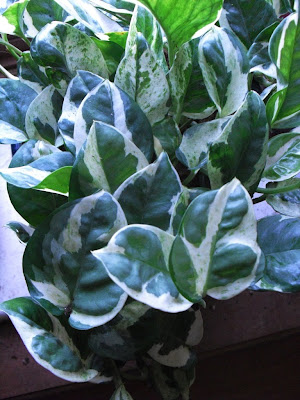
 Same plant. This picture is taken at a slight different angle, more accurately showing the relative sizes of the crested and regular portions of the plant.
Same plant. This picture is taken at a slight different angle, more accurately showing the relative sizes of the crested and regular portions of the plant. Close-up of the crest. A sunburn scar can be seen on a stem in the background. More detail can be seen in all three pictures if you click on them.
Close-up of the crest. A sunburn scar can be seen on a stem in the background. More detail can be seen in all three pictures if you click on them.

